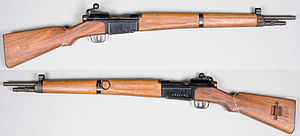MAS-36
| MAS-36 | |
|---|---|

|
|
| general information | |
| Military designation: | fusil modèle 1936 |
| Country of operation: | France |
| Developer / Manufacturer: | Manufacture nationale d'armes de St-Etienne (MAS) |
| Manufacturer country: | France |
| Production time: | 1936 to 1955 |
| Weapon Category: | gun |
| Furnishing | |
| Overall length: | 1020 mm |
| Weight: (unloaded) | 3.72 kg |
| Sight length : | 585 mm |
| Barrel length : | 575 mm |
| Technical specifications | |
| Caliber : | 7.5 x 54 mm |
| Possible magazine fillings : | 5 cartridges |
| Ammunition supply : | fixed box magazine |
| Cadence : | 10 rounds / min |
| Number of trains : | 4th |
| Twist : | right |
| Closure : | Cylinder lock with bolt handle |
| Lists on the subject | |
The MAS-36 was a French multi-loading rifle. It was not included in the equipment of the French army until 1936, making it the last rifle of its kind to become the orderly rifle of a larger armed force.
history
After winning World War I , the French military had other priorities than procuring modern weapons for their infantry. The Lebel Model 1886 and Berthier Model 1907 rifles, which were already obsolete in the last war, used the 8 mm Lebel cartridge . When developing new models, new ammunition should also be used to remedy the weaknesses of the old ammunition. Initially, it was decided to use the 7.5 × 58 mm cartridge, which, however, was too similar in dimensions to the German 8 × 57 mm IS cartridge and led to some serious accidents. Therefore, it was shortened to 7.5 × 54 mm in 1924, but these changes delayed weapon development. Troop trials with three applicants could only be carried out between 1933 and 1935. In 1936, the 7.5 mm model 1936 rifle was chosen. After the Manufacture de St-Etienne factory , it became known as the MAS-36. Production started slowly from 1938, so that only 63,000 units had been delivered before the start of the war in 1939.
The German Wehrmacht used captured MAS-36 stocks as Gewehr 242 (F). France resumed production after the end of the war. However, with the proliferation of self-loading rifles during World War II , the weapon was already obsolete.
Technology and commitment

The rimless cartridge in caliber 7.5 mm, which was developed for the Châtellerault M24 machine gun , was used. A conventional cylinder lock took over the locking. In contrast to rifles with the Mauser system, the locking lugs are at the back, so the bolt handle is far back and has been cranked forwards for easier access. Reloading turned out to be difficult. The stock was not continuous, but was mounted on the front and back of the system box, which houses a permanently installed box magazine. The fore-end was hollow and was used to accommodate a needle bayonet. The MAS-36 does not have any security mechanisms; the soldiers were instructed to load the weapon only immediately before the battle. The weapon was of a comparatively simple construction and was robust; with its short barrel also quite manageable.
At the beginning of the Second World War, there were only about 63,000 units in service, the armament mostly consisted of a hodgepodge of outdated models. During the war, both the German Wehrmacht and the Resistance seized the holdings. After 1945 the rifle was used on the French side in conflicts such as the Indochina War and the Algerian War . Later it was mainly given to colonial troops before it finally went to the reserve arsenal in the early 1960s.
variants
- MAS-36 CR39 : Paratrooper version with folding stock
- MAS-36/51 : Post-war model with a shooting cup for firing rifle grenades
- FR-F1 / F2 : heavily modified sniper rifle based on the MAS-36
Museum reception
One copy is in the Saarlouis City Museum .
Web links
- Le fusil de 7.5 mm modèle MAS 36 on armesfrancaises.free.fr (French)
- Il fucile MAS 36 on exordinanza.net (Italian)